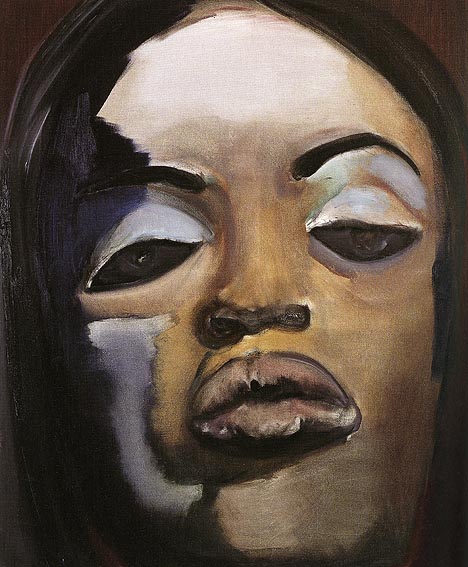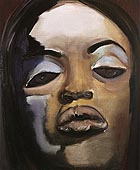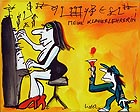
translated and summarized by: Liz Wollner-Grandville,
English summary November 11 - 20
Haus der Kunst
Tronies. Marlene Dumas and the Old Masters
29.10.10 until 06.02.11
Faces – Countenance or Mask
The viewer is responsible for that what he sees in a painting, Marlene Dumas asserted. Seeing is judging. Every type of seeing is a learnt form of seeing, an individual process. According to Dumas we are not only responsible for our judgements, but also for our misjudgements and our prejudices. The artist’s pictures offer the friction surface, which in turn allows us to interpret the pictures as we see them. The pictures presented in “Tronies. Marlene Dumas and the Old Masters” in the Haus der Kunst, focus on faces: faces of models, politicians, philosophers, art historical figures, as well as anonymous faces. Among them: angry, scared, sleeping, mocking, and laughing ones.
The human face, which, on the one hand is distinguishable, open and fragile, and on the other mask-like and withdrawn provokes judgements and prejudices – or, as the French philosopher Emmanuel Levinas, who is cited in the catalogue, once said: “The skin of a face is usually naked, denuded… The face reveals a certain poverty; proof is the attempt to mask this poverty by taking up certain expressions or postures.” The people in the Dumas' works also take on certain postures: such as the model Naomi Campbell. Her head thrown back, her eyes half closed: the picture questions everything that is associated with the well-known model. The same applies to other portraits; such as the one of Osama bin Laden. Visitors might be tempted to think that Al-Qaeda leaders don’t resemble the devil incarnate.
Marlene Dumas uses pictures published in the media, primarily press- and newspaper photographs. That means she selects, she doesn’t stage. That distinguishes her substantially from the Old Masters with which she is confronted in the exhibition: etchings, paintings and sketches by Peter Breughel, Frans Floris, Hedrick Goltzius, Rembrandt, Rubens. They all worked with a model or with a mirror and their own likeness. The presentation in Munich focuses on a certain type of picture painted by the Old Dutch Masters, so-called tronies, and character studies, created to practice sketching extreme types of people or states of mind. Apart from the high quality of these pictures the juxtaposition of the faces with those by Marlene Dumas works well: both, the Old Masters and the artist are concerned with existential psychological conditions. In her own reduced form of painting Marlene Dumas succeeds in creating highly sensitive pictures, which narrate about a very careful and human attitude towards facial expressions. In the confrontation of portraits of different eras there are interesting differences – especially with regard to the selection of the characters. Whichever differences we want to recognize – that is also something we are responsible for.
Astrid Mayerle
Haus der Kunst
80538 Munich, Prinzregentenstrasse 1
Tel.: +49 89 222655
Fax: + 49 89 2913424
email: mail@hausderkunst.de
www.hausderkunst.de
Opening hours: Mon – Sun 10 a.m. – 8 p.m., Thu 10 a.m. – 10 p.m.
Galerie Augustin – Vienna
Udo Lindenberg
05.11.10 – 27.11.10
Boobs and envy-emancipation
How can a successful artist arouse sympathy instead of envy - other than by spreading details about his faux pas in the yellow press? Success arouses envy, while failure triggers sympathy: but how can one remain successful and not be exposed to resentment?
After having seen Udo Lindenberg’s aquarelles and acrylic paintings in the Galerie Augustin one is relieved to find that there is a way out of the dilemma: by switching the discipline. As a painter, Udo Lindenberg is not obliged to be good, because the good of his painting is his personal signature. If Lindenberg would be a good painter one would have to envy him twice. However, his paintings prove that musicians offer numerous clichés a broad spectrum. For example the cliché of melon-sized breasts and their inspiration; or the cliché of the insatiable female object in the world of art – the mentioned large boobs as well as always present feminine lasciviousness, and the copulation shown in “At work” stirs up sympathy for men and how difficult its must be for them to deal with these “hot crevices”. Cliché number three: something one can’t paint can easily be written onto the picture. Cliché number four deals with the questions of filling a picture and that a true artist is able to reinvent the wheel. Cliché five deals with alcohol’s ability to sharpen ones perception of reality. Cliché number six: the artist’s presence on his paintings is indispensible, except on X-Mas paintings, and if the figure is not charming one can even attest the artist self-irony and a minimal portion of vanity.
It would be wrong to be envious of broadly presented clichés, and that’s what makes Lindenberg’s exhibition so liberating and insightful. He who really wants to be envious of really good painting will have to satisfy himself with the Art History Museum, but might console himself with the idea that artists displayed in the Art History Museum might have been envious of successful musicians. We eagerly await Lady Gaga’s paintings.
By Charles Nebelthau
Galerie Augustin – Vienna
1010 Vienna, Lugeck 3
Tel: +43 1 512 62 70
Fax: +43 1 512 62 70
email: galerieaugustin-wien@aon.at
www.galerie-augustin.com
Opening hours: Tue – Fri 11 a.m. – 1 p.m., 2 p.m. – 7 p.m., Sat 11 a.m. – 2 p.m.
Galerie Krinzinger
Erik Van Lieshout – Real Luxury
18.10.10 until 04.12.10
Koons’ Nightmare
If artists try themselves in other professions it can really go wrong. For three months Erik van Lieshout opened a shop in a mall in Rotterdam. After he already failed with his first idea: the strategy to rent himself out – as a handyman. People simply didn’t understand what he was attempting, he said. Therefore he decided to switch to selling goods, parts of which are currently displayed in the Gallery Krinzinger. The reconstructed shop looks like it was destroyed by hooligans and not at all like a well thought-out shop: screws, nuts, tools, pots filled with soil, plywood shelves and all kinds of other things created a chaos. Before entering one encounters the mounted message in capital letters stating that anti-consumerism is true luxury – definitely not the best advertising slogan.
Van Lieshout took his consumer-rebellion to the extreme. The reconstruction of his economically dysfunctional shop is accompanied by remarkably dismal drawings conveying the goings-on in a shopping centre - where everything seems out of control, although nothing spectacular is happening. The oversized hands of Valkyries are manicured in a nail studio; massive figures are sitting around on benches apparently waiting for something that will definitely not happen; the artist portraits himself with a totally blackened head, as if he was a victim of terrorism. Between these scenarios he positioned a poster with the trashy slogan “autonoom”, reminding of broken signs of neglected used-car shops.
With rather gloomy snapshots, Erik Van Lieshout demonstrates the smoothness of flashy shopping worlds. A nightmarish antithesis to Koon-, Hirst- or Murakami-like works. His downright destruction of consumer temple culture is refreshing in comparison to the at times hardly bearable commercialisation of everyday life – despite its slightly traditional aesthetics.
By Nina Schedlmayer
Galerie Krinzinger
1010 Vienna, Seilerstätte 16
Tel: 0043 1 513 30 06
Fax: 0043 1 513 30 0633
email: krinzinger@galerie-krinzinger.at
www.galerie-krinzinger.at
Opening hours: Tue – Fri 11 a.m. – 6 p.m., Sat 10 a.m. – 5 p.m.
MUSA – Museum auf Abruf
Mutations III – Personae: Personal Image, Public Role
05.11.10 until 27.11.10
Photography in the digital network
For a long time, the zero-euro-photo has been serious competition for an analogue photo. And for years the Internet replaced the classic distribution forms for this medium whose ephemeral character multiplied through digitalisation. Photographs are uploaded in seconds and published worldwide. Personal snapshots on Facebook and Twitter: one man’s joy and another man’s sorrow.
How artists utilize the Internet for photo-based works is presented by the main project of this year’s European Month of Photography, Mutations III. Public Images – Private Views. Institutions in Paris, Berlin, Bratislava, Luxembourg, Moscow and Rome are also displaying works under this motto.
The photographs mounted on the wall attempt to make it clear that a gripping reality will also be possible in the future. Hubert Blanz distilled one user out of 500 million Facebook-users, graphically abstracted the connection to his 1,500 contacts, and ultimately translated the digitalized result in a large-format Diasec presentation.
Visitors click through the show on a PC, visiting places such as the Caucasian Krasny Vostok near Sochi, and its partly underdeveloped infrastructure impressively documented by Rob Hornstra & Arnold van Bruggen. Or one can follow the traces laid out by Ewen Chardronnet & Benjamin Cadon with “Bangalore: Subjective Cartography”. Via mouse click Anders Bojen & Kristoffer Orum make things visible that are easily overlooked in an urban setting, and Susanne Wehr questions which identities are formulated if one posts private photographs on the Internet.
It was a wise decision to only use MUSA’s niches and transition zones for this presentation. Thereby the main room is reserved for the smallest art magazine of the world. Photo artist Sissi Farassat offers an insight into 33 editions of her magazine “Sioseh”. One only has to stick one’s head into cardboard boxes.
By Manisha Jothady
MUSA – Museum auf Abruf
1010 Vienna, Felderstrasse 6-8, next to the Town Hall
Tel.: +43 1 4000 8400
Fax: +43 1 4000 99 8400
email: musa@musa.at
www.musa.at
Opening hours: Tue – Fri 11 a.m. – 6 p.m., Thu 11 a.m. – 8 p.m., Sat 11 a.m. – 8 p.m.
Mehr Texte von translated and summarized by: Liz Wollner-Grandville


 Teilen
Teilen





